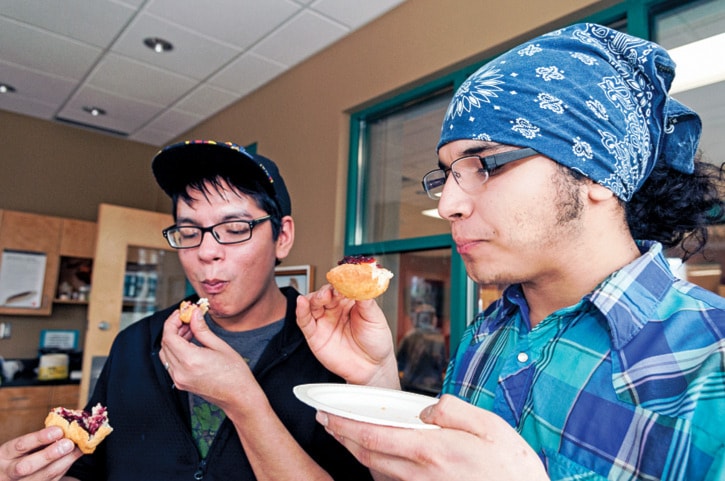One of the best bridges between cultures is a shared enjoyment of food.
It is a bridge that Caroline Chartier built on bannock recently.
The aboriginal transitions planner at Okanagan College created a bannock-making event, not just for enjoyment, but as a challenge to see who would earn bragging rights as the best bannock maker.
That honour went to Sharon Bailey of Mayfair Farms, with a young man from Manitoba coming in a close second.
Chartier says voting didn’t go quite the way she planned as rather than trying little bites of the five contestants’ bannock, people were helping themselves and eating a whole bannock.
“We probably had 60 to 75 guests to test the bannock and we had five contestants – one female student, two women, two young men, one from Arizona and another young man from Manitoba, who was pretty close to first place,” said Chartier of the fourth annual bannock contest.
This traditional First Nations food was originally made with flour from roots, natural leavening agents and a sweet syrup made from the sap of trees.

Chartier, however, provided the modern ingredients, which contestants used for their favourite recipes.
“It’s fun to have it, because so many claim to make the best bannock,” she said, noting that when it came down to the contest, she had some trouble getting people to put their bragging to the test.
Chartier says people tend to try and keep their recipes and secret ingredients to themselves, adding them to mix when nobody’s looking.
“I have seen people turn their backs and hunch their shoulders so nobody can see,” she laughs.
“Years ago, a nice elder from the Neskonlith would say ‘and now for the ancient Chinese secret.’”
When she is not creating fun activities, Chartier helps aboriginal students with more basic needs – housing, day care and funding for college fees.
“Finding funding for non-status aboriginals is really difficult; it is easier if they are connected to a band or are Métis,” she says. “I make sure students are connected to every service and that might be a food bank, Safe Society, medical and dental care and more.”
Chartier frequently visits band offices and schools in an effort to attract students to the college and hosts groups of students to tour the campus.
The proof that the system is working is in the bannock, so to speak.
“In early 2006, we had a very small handful of aboriginal students at the Salmon Arm campus,” she says. “We had 24 graduate from a six-month program last month and we have between 75 to 100 aboriginal students at the college in variety of programs.”
Chartier is hoping to get a great turnout to an Aboriginal Job Fair scheduled for Friday, March 6 from 10 a.m. to 4 p.m.
The event connects the underemployed and unemployed with potential employees.
Training and information will be available as well as some possible on-site interviews.
Hamburgers and hot-dogs will be served and there will be door prizes.
For more information on the job fair, call June Manuel at neccoordinator@neskonlith.net or call 250-463-4937.
Chartier is also enthusiastic about the Sixth Annual Multi-Cultural Day to be held at the college on Thursday, March 12.
Take a potluck dish to share and enjoy a variety of entertainment from 11 a.m. to 2 p.m.
